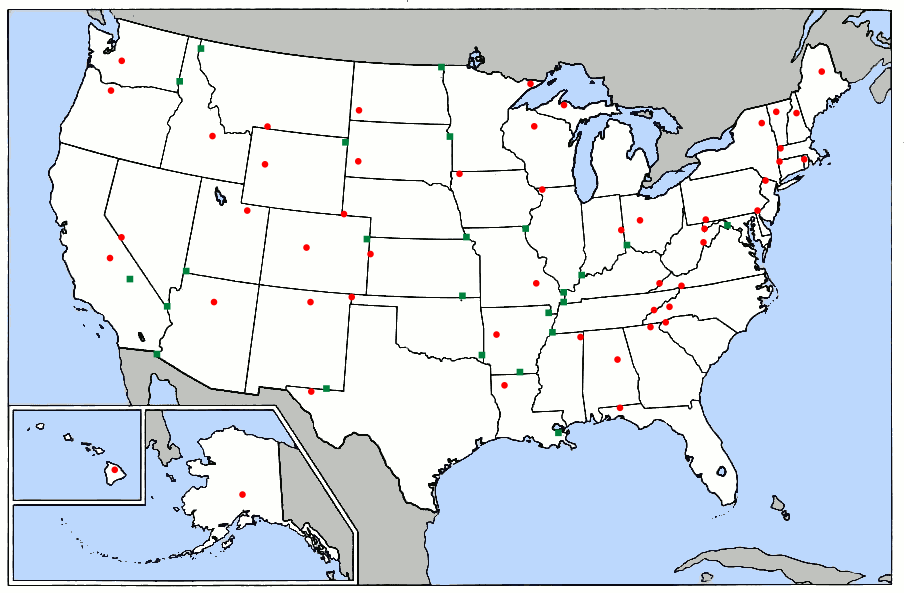Twelve Mile Circle received an intriguing question from reader “Cary” a few days ago. Cary, a professional mapmaker, noticed something interesting while conducting research: the amazing proximity of Minnesota’s highest point of elevation to its lowest. This led to a natural question. Was this the shortest distance between a state highpoint and a lowpoint?
I’d touched on something within a similar vein way back in 2008 in “Highest and Lowest, Oh So Close” However, I’d discussed only the curious case of California with its astounding elevation difference between Mount Whitney at 14,494 feet (4,418 meters) and Death Valley at -282 ft (-86 m). The two points were separated by only 88 miles (142 kilometers).
That earlier article didn’t answer anything to determine if those 88 miles represented the absolute shortest distance between highpoints and lowpoints; it simply noted that the distance was very small. Fortunately numerous sources existed on the Intertubes so I could steal — with proper attribution of course — wonderful items such as this map that had already been prepared to assist with such a quest.

My quick eyeball assessment uncovered a few observations. The California distance was indeed very short. It wasn’t the shortest. Minnesota was shorter and a couple of east coast states might be viable too. There was also one other curious fact. With the exception of California and Louisiana with lowpoints below sea level, the lowest elevation in each state appeared to fall somewhere along its border where it abutted another state or a large body of water. I supposed that reflected water always seeking the lowest level as it flowed downhill.
Minnesota

The Minnesota highpoint mentioned by Cary was Eagle Mountain (map) at 2,301 ft (701 m). The elevation certainly didn’t rival California’s Mt. Whitney! However, the summit was only about 12.8 miles (20.6 km) from the state’s lowpoint on the shores of Lake Superior. The lake had a consistent elevation so it was only a matter of finding the closest line between mountain and shoreline.
I noticed that Michigan’s highpoint on its Upper Peninsula also fell remarkably close to Lake Superior. I felt a momentary sense of elation until I realized that Michigan touched several of the Great Lakes including Lake Erie way down at the southeastern corner of the Lower Peninsula. Lake Erie, being considerably downstream from Lake Superior, obviously had a lower elevation and thus the Michigan highpoint and lowpoint were separated by hundreds of miles.
Rhode Island

When checking for diminutives, one should always examine the smallest of U.S. states, Rhode Island. Right? Little Rhody failed to reign supreme this time around. It’s highpoint was Jerimoth Hill (map). However that was located on the far western edge of the state almost all the way to Connecticut. That put it some distance from the nearest stretch of sea-level elevation, which even in this very tiny state measured 19.2 miles (30.9 km) by my rough estimation.
Delaware

Then came the geo-oddity magnet that was Delaware. I’ve mentioned repeatedly that I believe Delaware holds more geographic anomalies per square mile than any other place in the United States. And the streak continues!
Delaware’s highpoint occurred at Ebright Azimuth (12MC’s visit). Its lowpoint was at sea level which I’ve experienced many times along its wonderful Atlantic Ocean beaches. However the highpoint (map) was certainly too far away from the Atlantic coast to make it a top contender. The Delaware River, conversely, flowed quite close to the azimuth. Could the Delaware River along that stretch have an elevation of zero? I figured it might be possible. For instance, I knew that the Potomac River at Washington, DC, in an area of similar terrain was only about six inches above sea level considerably farther inland.
I thought 12MC might have to call out to the hydrologists in the audience to see if we could calculate the elevation of the Delaware River at the point closest to Ebright Azimuth. Then it dawned on me. I didn’t need to do anything of the sort. I simply needed to learn if the Pennsylvania lowpoint located farther upstream had an elevation at sea level or not. Many sources listed that statistic so it should be easy.
Bingo! Pennsylvania’s lowpoint was at sea level on the Delaware River at the Delaware border. Therefore the Delaware River flowing through Delaware, being downstream from Pennsylvania, had to have that same sea level elevation by definition. That qualified it as part of the state’s lowpoint.
A rough measurement generated a Delaware highpoint-to-lowpoint distance of approximately 4.3 miles (6.9 km).
Thank you Cary for the suggestion.

Leave a Reply